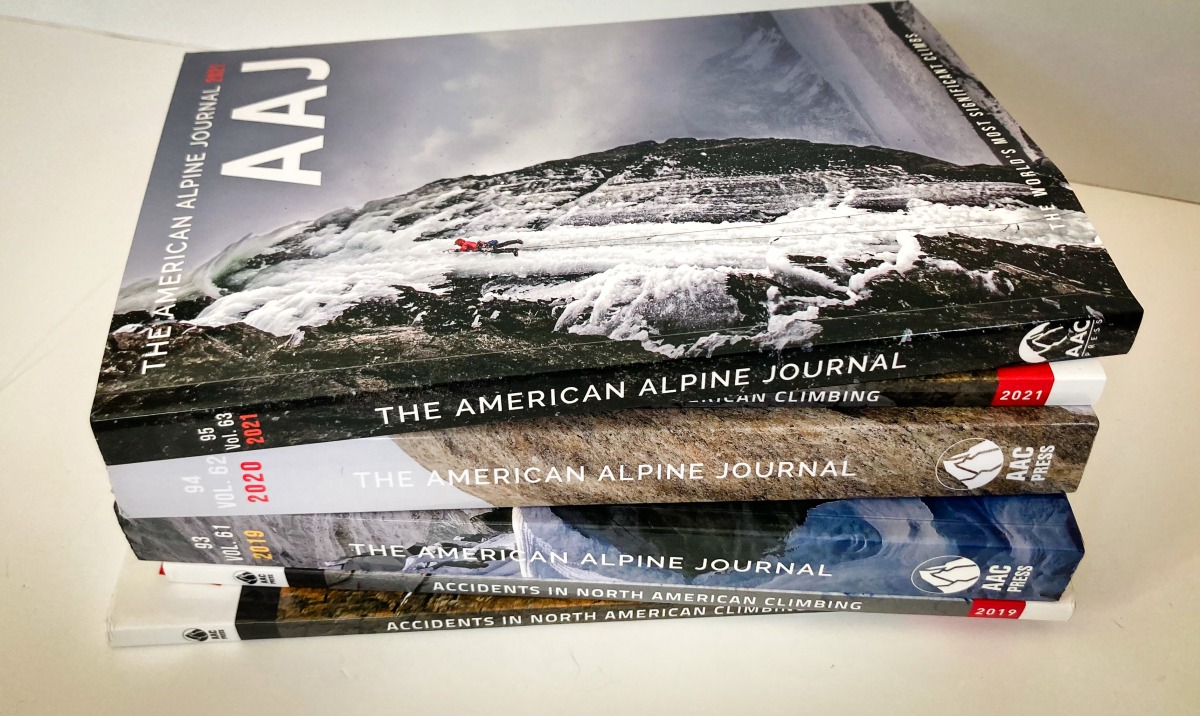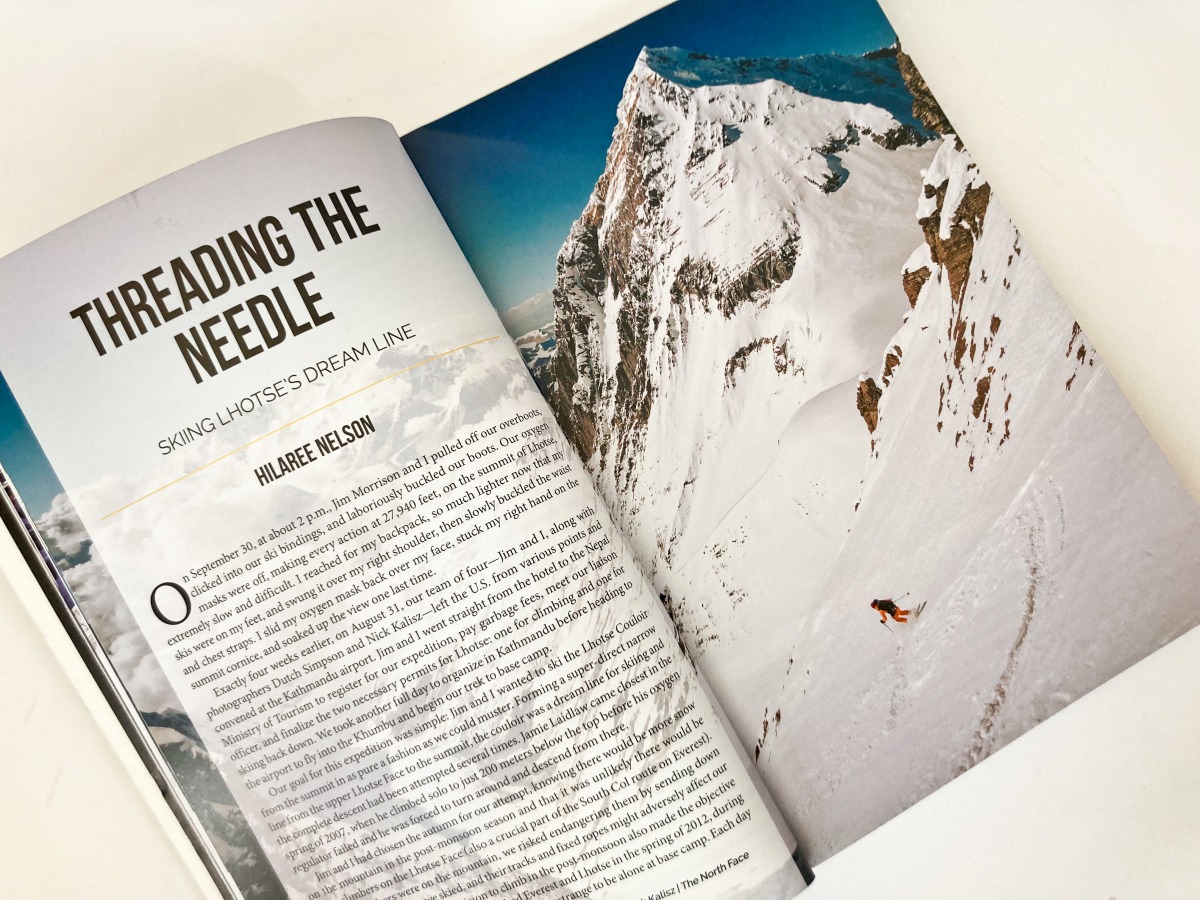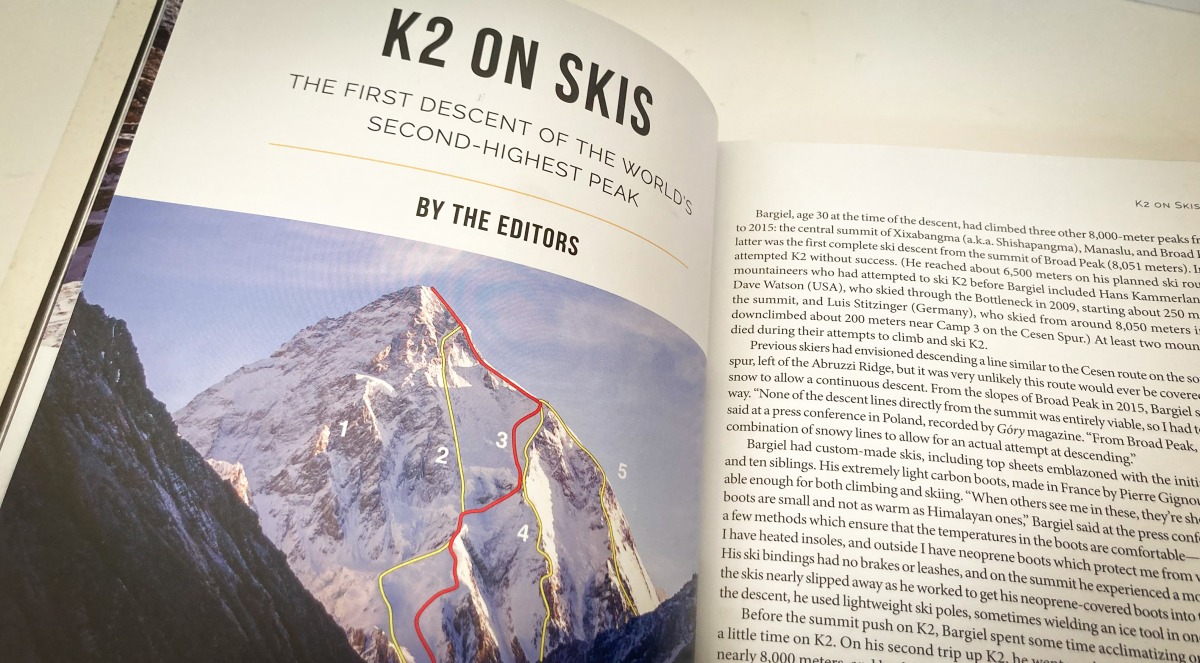For many hardcore climbers and alpinists, the arrival of the American Alpine Journal (AAJ) and Accidents in North American Climbing (ANAC), is a present-under-the-tree moment. First, there’s the anticipation, then the unboxing and page-turning. The AAJ has long been considered the “journal of record” for alpine climbing and mountaineering highlighting “The World’s Most Significant Climbs.”
(Both resources, the AAJ and ANAC, are publications of the American Alpine Club (AAC). Full disclaimer, I’m a member of the AAC.)
The AAJ includes formal essays, reports from across the globe, route descriptions, and gear-catalog-worthy photos but without commercial intrusion – it’s a non-profit publication. For the devoted, the AAJ embodies something ecclesiastical – climbers’ mental and physical devotion and their singular obsession enshrined between two covers. It’s the best and the brightest of badass alpinism.
The AAJ can be off-putting too. Who is to say what is and what is not significant when questing in the mountains? But, to put it bluntly, we are human, and this is what we do: itemize, categorize, and construct hierarchy. We like to determine overall significance. If you buy into the AAJ, some things in the mountains are less significant than others.
Backcountry skiing, since its inception, has embodied more soul than sport. The banter around best-and-better powder shots is more suited for barroom spray. On the other hand, ski mountaineers have embraced the ethos of documenting first descents, FKTs, and good style debates.
In part one of our series on style, Lou Dawson argued that style matters when considering ski mountaineering descents. Still, it remains rather loose in terms of who the judges are of significant ski descents. A great part of the endeavor is that no panel of judges raises a scorecard with a 0.9 point deduction if you side slip.
Recently, the AAJ has included more ski mountaineering in its annual coverage. Turn one page into the 2021 AAJ; Eivind Jacobsen is traversing a spicy snow face, skis strapped to his pack, on his way to an eventual first ski descent in Norway’s Lyngen Alps. On page 81, there’s a write-up of an Mt. Owen (Wyoming) ski descent. Page 100 features “Une Grand Adventure,” a whopping 48-day tour, climb, and descent of Canada’s Mt. Logan.
The 2019 AAJ ran stories on Polish ski mountaineer Andrzej Bargiel’s descent of K2 and the Lhotse Couloir ski by Hilaree Nelson and Jim Morrison. These descents seem, at their core, significant.
In fact, diving into the AAJ’s search engine reveals intermittent ski coverage since the 1930s. The inclusion of ski mountaineering is not a one-off for the AAJ.
(This year, the ANAC includes a section titled “Backcountry Avalanches,” in which several avalanches from last winter are reported upon and analyzed.)
As an advocacy group, the climbing-centric AAC has morphed from its starched collar siege tactic legacy into a more inclusive entity. Increasing the membership roles is in their best interest — backcountry skiers are not an insignificant portion of the outdoor adventure community. You get my drift; ski mountaineering in the AAJ allows the AAC to cast a wider net.
That’s the cynic in me.
Since its inception, AAJ editors have debated where they draw the lines for a new climbing route’s inclusion. The target has moved – does a 5.15c sport climb deserve recognition in their pages or not? Hard to say as they seem to have landed on big climbs in the mountains; for good reason, that includes climbs on roadside big walls like El Capitan.
The AAJ and its ski-advisory group have stepped into the void as the unofficial arbiters reporting significance. (We say that with the caveat that not all ski mountaineers are publicizing their adventures.)
In this second part of our series on style, we reached out to the longtime editor of the AAJ, Dougald MacDonald, to learn more about ski mountaineering’s place in the AAJ and where it might all go from here.
WildSnow: What is the broad mission of the AAJ? (I’m thinking historically and also how you are adapting to different user groups, e.g., ski mountaineers).
Dougald MacDonald: As a general comment, I will say that the AAJ has never focused exclusively on technical climbing and mountaineering. For example, the book used to cover polar expeditions, and it also has reported a lot of what might generally be called mountain exploration, even when no technical climbing was involved.
In fact, we probably would take an even broader view of the climbing world except for the limitations of space and time: not enough pages in the book, not enough time to fill the unlimited space of the website. We have an informal minimum length for the climbs we cover, but this is not because we think shorter climbs aren’t deserving. We just don’t have enough time or space.
In my own time as editor (EIC since late 2012—starting with the 2013 book—and features editor from AAJ 2006 to AAJ 2010), I’ve taken a pretty broad view of what constitutes a notable achievement in the mountains, whether it’s a new route, a first free ascent, a speed ascent, a linkup or a peakbagging traverse. In this light, skiing is just part of a range of ways that mountain athletes express themselves.
Personally, I love creative efforts that combine disciplines: for example, flying in to do a big climb and then skiing or packrafting out. We’re going to be giving quite a lot of space in next year’s book to teams on Denali in 2021 that combined climbing and skiing in interesting ways. It’s cool to see techniques that have been used in the Alps for years starting to be seen more frequently—and impressively—in North American mountains.
Looking ahead, it’s very likely that the AAJ and similar publications will report less and less on geographic exploration (first ascents and new routes), simply because there will be less and less new geography to explore. Instead, the focus will be more on performance and the exploration of human limits: free climbing, speed, and, for sure, ski descents.
Finally, we just think a lot of readers will be interested in these stories, since many of them are avid skiers as well as climbers.
When I started looking to expand our ski mountaineering coverage, I thought we might only cover descents that involved climbing a peak first. That is, the descent would have to start right from the top of a mountain. But I quickly realized that some very notable descents wouldn’t necessarily meet this standard, and also that the summit was sort of beside the point, in many cases. – AAJ Editor Dougald MacDonald
WS: Do you recall the context in which you(as an editor) first included a ski descent in the AAJ?
DM: I’m far from the first AAJ editor to cover ski descents. They go back at least to the 1980s and I’m sure before that. In fact, in a very hasty search of our archives, I found a story from the 1930s about skiing in the Sierra.
What’s new is that it used to be more random, and now there’s an effort to ensure we document many of the most significant descents each year. I can’t recall the exact year we implemented this, but it’s been three or four years now. We have a VERY informal advisory committee, chaired by Brody Leven, that helps us identify potential descents to document, and also to make good decisions on which ones to prioritize. They don’t operate like a traditional selection committee, but these folks are very helpful when I have a question.
WS: In our first email exchange, you noted the AAJ has struggled to define the line “between true ski mountaineering (which has always been part of our mix) and other forms of backcountry skiing (couloir descents, etc).” Can you elaborate on what those struggles or discussions were like?
DM: I don’t think we’ve resolved this question! When I started looking to expand our ski mountaineering coverage, I thought we might only cover descents that involved climbing a peak first. That is, the descent would have to start right from the top of a mountain. But I quickly realized that some very notable descents wouldn’t necessarily meet this standard, and also that the summit was sort of beside the point, in many cases.
Similarly, I’ve come to understand that skiers’ standards for what constitutes a clean or pure descent are somewhat different from how many climbers view their ascents. Most importantly, as a climber, I tended to view rappels in ski descents as a form of aid. But serious skiers have helped me understand that, although a rappel-free descent might be the ideal, a necessary rappel or two doesn’t take away from an otherwise spectacular descent. I suppose it’s like fixed ropes on a big mountain route: We wouldn’t give much space to a new route on a 7,000-meter peak in the Himalaya that involved extensive use of fixed ropes, but it’s quite common to see alpine-style teams fix a rope or two above a bivy to get a quick start in the morning, and this doesn’t detract from the “purity” of their climb.
Ultimately, I think we are following a “you know it when you see it” approach to selecting the descents we cover. Certain ones just seem to fit naturally into the AAJ’s traditional sphere of coverage.
WS: I’m making an assumption, but I’ll throw it out there, a motorized assisted ascent to access the descent precludes its inclusion in the AAJ? (To clarify motorized assistance: a heli-assist to the top/shoulder of a mountain, but not necessarily a snow machine, heli, or plane ride to an adjacent glacier/access point.)
DM: Yeah, this one is clearer: We’re definitely not interested in descents that start with a heli lift up the mountain. But we’re also fully cognizant that many great climbs begin with air access (or snow machines or 4WD, etc.). I guess this speaks to the previous question a bit: To me, a descent appropriate for the AAJ is one in which the ski down is just part of an overall mountain adventure, not the sole focus of the day. In other words, there should be significant climbing involved, as we are a climbing publication. Hah!
WS: In the 2019 AAJ, you folks opened with a few ski mountaineering pieces, one of the (unreal) K2 descent and another by Hilaree Nelson and Jim Morrison. Two huge ski-news stories beyond the AAJ. Were these two stories no-brainers for inclusion? And curious, from an editor’s perspective, they are front and center in the publication; what does that say about the rise of ski mountaineering and its embrace by the AAJ (which historically we have associated with alpinism/mountaineering/climbing)?
DM: Both of these seemed like no-brainers. The K2 one seemed to me like pretty much the mountain feat of the year (up or down). And we liked the history on Lhotse: an obvious line that had seen several prior attempts. Plus, in both cases, it’s relatively rare that something very significant happens on the 8000-meter peaks, which mostly see commercial expeditions these days.
Our front-of-book feature articles usually reflect the climbs (or descents) that we regard as most significant or interesting each year, but not always. Sometimes we use them to highlight a trend or reveal a “new” area or look back at a historical moment. There will be a skiing story in AAJ 2022 that’s more in this vein. But, yes, I think it’s safe to say that featuring two ski descents in the same edition is a clear indication that we consider ski alpinism to be very much a part of our mix.
WS: Curious if you as an editor received any pushback from more traditional perspectives of what should or should not be included in the AAJ?
DM: Nope. I think the readership recognizes that the AAJ is simply trying to document the mountain world as it happens. To cite an extreme example, it would have seemed very strange to me—and I think to the readers as well—if we had not covered the ski descent of K2 prominently.
WS: How would you encourage skiers to use the AAJ as a resource to sniff out new terrain to climb and ski?
DM: Photos are the most obvious thing. We publish hundreds of them, many from lesser known ranges around the world.
Less obvious to many readers is the fact that we publish at least five times as many photos online each year as we do in the book. (That is, we have since 2013, when we launched our online archives: Most reports from 2013 to today, and many from around 2006 until 2012, have lots of photos online.) If a reader spots a peak or area that might be interesting, I strongly encourage them to start searching our archives (publications.americanalpineclub.org) to see what else they can find.
Pro tip: Make a list of peak, glacier and valley names in the area you’re studying, so you can search those terms too. We’re working on geographic (map-based) searches, but for now you often need to search multiple terms to cover an area well.
Pro tip 2: If an article before 2013 has no photos, try downloading the PDF for the story (PDF icon in upper right of each article page). Many earlier stories were scanned with their photos, but the photos won’t necessarily be visible unless you download the PDF.

In 2020, the AAJ’s tagline was “The World’s Most Significant Long Climbs.” In 2021, that changed to “The World’s Most Significant Climbs.”
WS: I love the AAJ‘s qualifier on the cover, “The World’s Most Significant Long Climbs”. I’m pretty confident I understand the meaning. But with ski mountaineering in the mix, any chance we’ll see a qualifier 2.0?
DM: Hah-hah, no, not right away. But we’ll think about it. BTW, we actually dropped “Long” from the tagline in 2021, after I added it a couple of years ago. There was a general feeling that it wasn’t necessary. There’s never going to be one tagline that describes everything we do.
Incidentally, we have the same problem (maybe even bigger!) with the AAC’s Accidents book. A few years ago, we changed it from Accidents in North American Mountaineering to Accidents in North American Climbing, because we cover so many rock climbing accidents, and ever since we’ve been doing more and more skiing! In 2021 we even added a 15-page section of avalanche incidents involving backcountry skiers and snowboarders. I doubt we’ll change that book’s title either, but you never know.
Jason Albert comes to WildSnow from Bend, Oregon. After growing up on the East Coast, he migrated from Montana to Colorado and settled in Oregon. Simple pleasures are quiet and long days touring. His gray hair might stem from his first Grand Traverse in 2000 when rented leather boots and 210cm skis were not the speed weapons he had hoped for. Jason survived the transition from free-heel kool-aid drinker to faster and lighter (think AT), and safer, are better.




